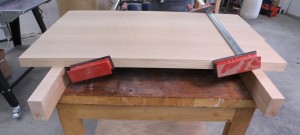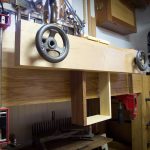We may receive a commission when you use our affiliate links. However, this does not impact our recommendations.
For the last few decades, I’ve kept one indispensable tool readily available in my shop – glue sticks. Basically, they are milled material about 2″ thick and around 4″ wide (in my shop they were always made from hardwood because there was always plenty of scrap) that is cut to approximately 3′ in length.
The idea is to elevate the material you are gluing up in order to be able to get clamps above and below with little or no fuss. I usually mill my sticks flat, square and uniform in width, and I use them in pairs unless I’m gluing something extremely long – then I’ll use three or more.
Another reason to use milled glue sticks is they give you a reference. If you only flatten one face of the boards you’re gluing, you can put those faces against the sticks and you’ll stand a better chance of having them come out flush to one another. All you need to do is apply a bit of clamp pressure and tap the boards down against the glue sticks.
Using the glue sticks also allows you to get your clamps in the proper position. Ideally, you want to get the center of the clamp screw lined up with the center of the boards you’re gluing. Doing so equalizes the pressure from the clamps and helps keep your glue-ups flatter. By putting clamps on both sides of the boards, if you are applying enough pressure to bow the glue-up, you’re less likely to have the material spring free of the clamps because the pressure from each clamp opposes the other.
Lastly, when you’ve got the boards glued and you need to clear your work space, stand the assembly up on end. This way your glue joints are vertical and, if you have a little excess glue squeezing out of the joints, it won’t run down across the face of your boards. I usually let the glue set up for 10 or 15 minutes, then take a chisel and scrape the gelled glue from the surface. I’ve always found that using water to remove the glue just raises the grain and smears the glue into the pores.
Next time you’re getting ready for a project that requires you to glue narrow boards together, give your work a lift on some glue sticks and see if they don’t make your life easier.
To see David Thiel’s take on gluing, check out this digital download.
Here are some supplies and tools we find essential in our everyday work around the shop. We may receive a commission from sales referred by our links; however, we have carefully selected these products for their usefulness and quality.












I have been using blue painters’ tape on my glue sticks. following the build-up of glue from some number of glue-ups I simply change the tap. With the tape I haven’t glued the sticks to the stock as sometimes happened before. I find that the glue sticks also lets me use less expensive f-clamps for larger projects
Great idea! Thanks
Any advice on keeping your material from becoming permanently attached to your glue sticks when you forget at the end of the day? Will a coat of wax take care of the problem or is clear packing tape a better solution?